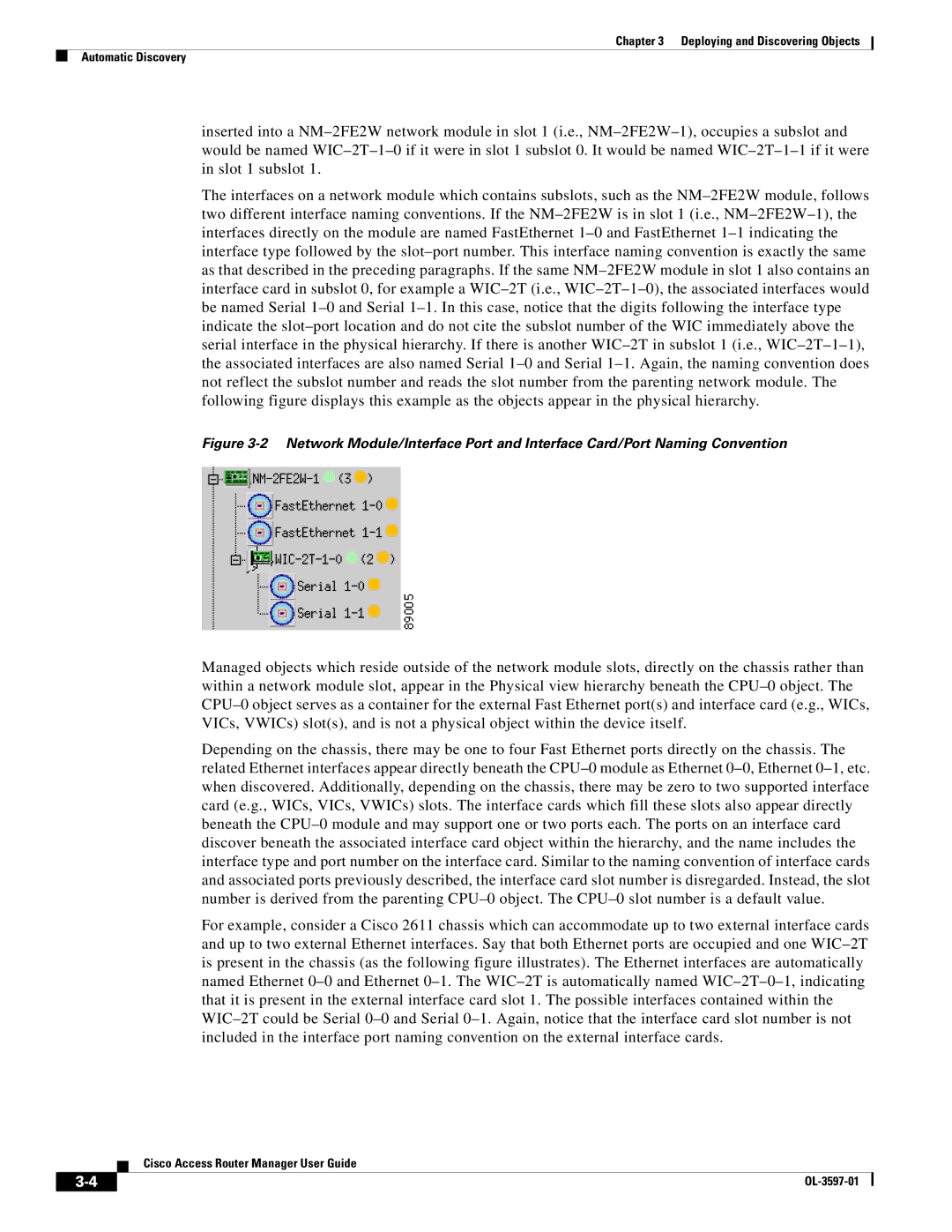Chapter 3 Deploying and Discovering Objects
Automatic Discovery
inserted into a NM–2FE2W network module in slot 1 (i.e., NM–2FE2W–1), occupies a subslot and would be named WIC–2T–1–0 if it were in slot 1 subslot 0. It would be named WIC–2T–1–1 if it were in slot 1 subslot 1.
The interfaces on a network module which contains subslots, such as the NM–2FE2W module, follows two different interface naming conventions. If the NM–2FE2W is in slot 1 (i.e., NM–2FE2W–1), the interfaces directly on the module are named FastEthernet 1–0 and FastEthernet 1–1 indicating the interface type followed by the slot–port number. This interface naming convention is exactly the same as that described in the preceding paragraphs. If the same NM–2FE2W module in slot 1 also contains an interface card in subslot 0, for example a WIC–2T (i.e., WIC–2T–1–0), the associated interfaces would be named Serial 1–0 and Serial 1–1. In this case, notice that the digits following the interface type indicate the slot–port location and do not cite the subslot number of the WIC immediately above the serial interface in the physical hierarchy. If there is another WIC–2T in subslot 1 (i.e., WIC–2T–1–1), the associated interfaces are also named Serial 1–0 and Serial 1–1. Again, the naming convention does not reflect the subslot number and reads the slot number from the parenting network module. The following figure displays this example as the objects appear in the physical hierarchy.
Figure 3-2 Network Module/Interface Port and Interface Card/Port Naming Convention
Managed objects which reside outside of the network module slots, directly on the chassis rather than within a network module slot, appear in the Physical view hierarchy beneath the CPU–0 object. The CPU–0 object serves as a container for the external Fast Ethernet port(s) and interface card (e.g., WICs, VICs, VWICs) slot(s), and is not a physical object within the device itself.
Depending on the chassis, there may be one to four Fast Ethernet ports directly on the chassis. The related Ethernet interfaces appear directly beneath the CPU–0 module as Ethernet 0–0, Ethernet 0–1, etc. when discovered. Additionally, depending on the chassis, there may be zero to two supported interface card (e.g., WICs, VICs, VWICs) slots. The interface cards which fill these slots also appear directly beneath the CPU–0 module and may support one or two ports each. The ports on an interface card discover beneath the associated interface card object within the hierarchy, and the name includes the interface type and port number on the interface card. Similar to the naming convention of interface cards and associated ports previously described, the interface card slot number is disregarded. Instead, the slot number is derived from the parenting CPU–0 object. The CPU–0 slot number is a default value.
For example, consider a Cisco 2611 chassis which can accommodate up to two external interface cards and up to two external Ethernet interfaces. Say that both Ethernet ports are occupied and one WIC–2T is present in the chassis (as the following figure illustrates). The Ethernet interfaces are automatically named Ethernet 0–0 and Ethernet 0–1. The WIC–2T is automatically named WIC–2T–0–1, indicating that it is present in the external interface card slot 1. The possible interfaces contained within the WIC–2T could be Serial 0–0 and Serial 0–1. Again, notice that the interface card slot number is not included in the interface port naming convention on the external interface cards.
Cisco Access Router Manager User Guide

